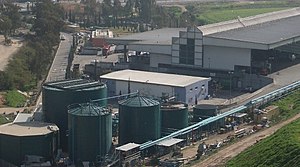Upflow anaerobic sludge blanket digestion

Upflow anaerobic sludge blanket (UASB) technology, normally referred to as UASB reactor, is a form of anaerobic digester that is used in the treatment of wastewater.
The UASB reactor is a methanogenic (methane-producing) digester that evolved from the anaerobic clarigester. A similar but variant technology to UASB is the expanded granular sludge bed (EGSB) digester. A diagramatic comparison of different anaerobic digesters can be found here.
UASB uses an anaerobic process whilst forming a blanket of granular sludge which suspends in the tank. Wastewater flows upwards through the blanket and is processed (degraded) by the anaerobic microorganisms. The upward flow combined with the settling action of gravity suspends the blanket with the aid of flocculants. The blanket begins to reach maturity at around 3 months. Small sludge granules begin to form whose surface area is covered in aggregations of bacteria. In the absence of any support matrix, the flow conditions creates a selective environment in which only those microorganisms, capable of attaching to each other, survive and proliferate. Eventually the aggregates form into dense compact biofilms referred to as "granules".[1] A picture of anaerobic sludge granules can be found here.
Biogas with a high concentration of methane is produced as a by-product, and this may be captured and used as an energy source, to generate electricity for export and to cover its own running power. The technology needs constant monitoring when put into use to ensure that the sludge blanket is maintained, and not washed out (thereby losing the effect). The heat produced as a by-product of electricity generation can be reused to heat the digestion tanks.
The blanketing of the sludge enables a dual solid and hydraulic (liquid) retention time in the digesters. Solids requiring a high degree of digestion can remain in the reactors for periods up to 90 days.[2] Sugars dissolved in the liquid waste stream can be converted into gas quickly in the liquid phase which can exit the system in less than a day.
UASB reactors are typically suited to dilute waste water streams (3% TSS with particle size >0.75mm).
Advantages over conventional treatment
Conventional treatment settles sludge which is then digested, and then aerates the remaining liquids which use bacteria to oxidise the potential digester fuel, and uses up energy to drive the compressors. The result is that on a standard western treatment works the energy produced from settled sludge digestion is all used by the aeration process, with little power export.
With UASB, the whole process of settlement and digestion occurs in one or more large tank(s). Only the post UASB liquids, which have a much reduced BOD concentration, needs to be aerated.
This leads to a halving of the aeration energy and doubling of the power generated from digestion, leading over all to a tripling of power generated.
See also
- Anaerobic digestion
- Anaerobic digester types
- Anaerobic clarigester
- Relative cost of electricity generated by different sources
- Ecological sanitation
- Environmental technology
- Anaerobic filter
- Expanded granular sludge bed digestion
- Hybrid reactor (combination of UASB and an anaerobic filter (AF))
- Fluidized bed reactor
- Mechanical biological treatment
- Sewage treatment
- biogas
External links
- Bal AS, Dhagat NN (April 2001). "Upflow anaerobic sludge blanket reactor—a review". Indian J Environ Health. 43 (2): 1–82. PMID 12397675.
- Lettinga G, Rebac S, Zeeman G (September 2001). "Challenge of psychrophilic anaerobic wastewater treatment". Trends Biotechnol. 19 (9): 363–70. doi:10.1016/S0167-7799(01)01701-2. PMID 11514000.
{{cite journal}}: CS1 maint: multiple names: authors list (link) review - Lettinga G (1995). "Anaerobic digestion and wastewater treatment systems". Antonie Van Leeuwenhoek. 67 (1): 3–28. doi:10.1007/BF00872193. PMID 7741528.
- www.uasb.net
References
- ^ What are sludge granules? UASB Homepage
- ^ Finstein, M.S., Zadik, Y., Marshall, A.T., Brody, D. (2004). "The ArrowBio Process for Mixed Municipal Solid Waste – Responses to "Requests for Information"" (PDF). In Papadimitriou, E.K., Stentiford, E.I. (ed.). Biodegradable and Residual Waste Management. 1st UK Conference and Exhibition on Biodegradable and Residual Waste Management, February 18–19, 2004, Harrogate, UK. Leeds: CalRecovery Europe Ltd. pp. 407–413. ISBN 0-9544708-1-8.
{{cite conference}}: Unknown parameter|booktitle=ignored (|book-title=suggested) (help)CS1 maint: multiple names: authors list (link)
